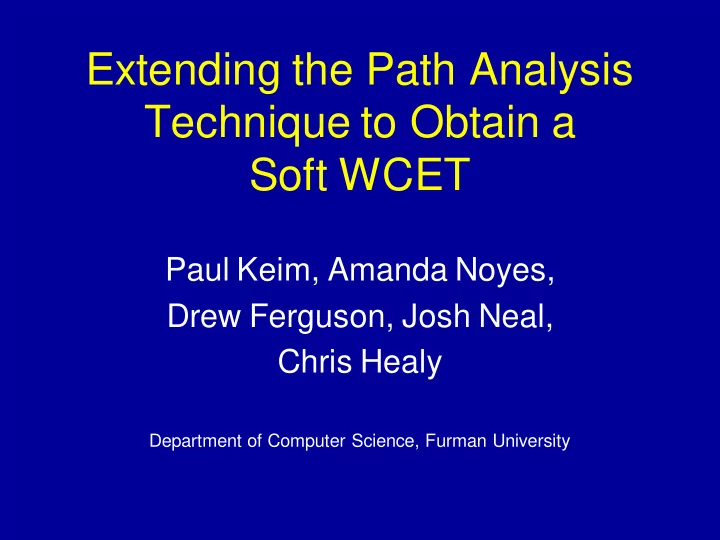

Extending the Path Analysis Technique to Obtain a Soft WCET Paul Keim, Amanda Noyes, Drew Ferguson, Josh Neal, Chris Healy Department of Computer Science, Furman University
Overview • Hard versus soft WCET • Incorporating soft WCET in loop analysis algorithm • Study of benchmarks • Comparison of static timing analysis • Ongoing & future work • Conclusions
Motivation • Need to bound WCET of tasks. – Static timing analysis tools • Can we tolerate an occasional missed deadline? – Hard RT system: NO. WCET is absolute – Soft RT system: YES. A WCET estimate that almost always bounds the actual WCET is acceptable. • Traditional WCET analysis has been for hard RT – Estimates can be quite loose due to input data
For example … • Consider a simple distribution of possible execution times, compared to “hard” WCET Observed: 822 to 978 BCET = 600 WCET = 1200
Goal • We want to provide a tighter WCET bound, which may underestimate the actual execution time in rare cases (< 1%). • Extend earlier work in timing analysis – Statically determine the distribution of execution times. • Need to also update hardware simulator so it also produces time distributions: interesting case studies.
Loop analysis • In our “path analysis” approach, we do the analysis bottom up. Instruction path loop function task. – The loop’s execution time distribution depends on its paths. – Multiple paths result from conditional control flow. – Choice of path typically depends on input data, unknown at compile time. – 1 path : trivial – 2 paths : we use binomial probability technique – 3+ paths : repeated application of (2)
2 path case Let A = longer path and B = shorter path compute A time and B time as well as A prob and B prob total_prob = 0.0 for i = 0 to n p = probability that A is taken on i of the n iterations and B is taken on (n – i) iterations for j = 100*total_prob to 100* (total_prob + p) time_dist[ j ] = A time * i + B time * (n – i) total_prob += p
More paths? • Consider case of 4 paths (A,B,C,D) with equal probability of being taken. – Use 2 case model to find time distributions TD A+B and TD C+D . – Concatenate the two TD’s. Sort the values, and remove every other element (because they were the same size) to normalize size of the TD. • What if (A+B) prob > (C+D) prob ? – Before you concatenate, stretch TD A+B by a factor of (A+B) prob / (C+D) prob
Methodology • Benchmark tasks with random input data • Timing analyzer only needs to be run once, because it ignores the input data. • Using hardware simulator – 1000 trials of benchmark program – Automatically generate next version of benchmark, compile and run. – Testing is easier for soft WCET than for hard WCET because we don’t need to figure out the WC input data.
Simulated observations • Each time we ran a randomized version of a benchmark, we computed: observed execution time / predicted WCET. (As a percent) • We took note of: – Width of the observed distribution – Skewness – The observed soft WCET. In one case this was as low as 2%. – Different loops in the same function – Effect of changing the distribution of input values. (“fair” versus “unfair”)
Result with 7 paths
Ongoing & Future • Combining multiple loops • More realistic estimate of probability of taking a branch • Open questions: – Consider other probability distributions? – How to measure “how close” static and dynamic distributions are? • GUI and Website cs.furman.edu/~sparta • Combine with work on parametric timing analysis to produce distribution of polynomial coefficients.
Conclusion • Extend our existing framework for bounding hard WCET to generate: – static prediction for soft WCET, – as well as entire execution time distribution. • Incorporated into existing timing analyzer, giving rapid result for all loops in program. • Scales well with ↑ number of paths. • Potential benefit for system developers if hard and soft WCET differ substantially.
Recommend
More recommend